A Private Tour today, in North Norfolk, looking for some of our regular wintering species. It was forecast to rain this morning, and it certainly started cloudy with some drizzle, but thankfully that cleared very quickly and we even had some blue sky and sunshine by the afternoon. In the damp conditions first thing, we decided to head up to the west end of the coast, so we would have the option of the hides at Titchwell if need be.
As it was, when we got there the weather wasn’t too bad so we carried on along to Thornham first. As we drove down to the harbour, the tide was almost in and several waders were feeding of bathing on the strip of mud left along the edge of the main channel. We had great views of several Bar-tailed Godwits and a single Black-tailed Godwit side by side, a lovely comparison of these two easily confused species, plus a Curlew and a couple of Common Redshanks nearby.
As we got out of the car, we could see another wader out on the mud the other side of the road. It was noticeably paler than the Common Redshanks we had seen earlier, with a longer finer bill, a Spotted Redshank. Most head down to the Mediterranean or Africa for the winter from their Arctic breeding grounds, but a very small number stay the winter here. They often feed out in the muddy channels on the saltmarsh, and this one had probably been pushed out by the rising tide.
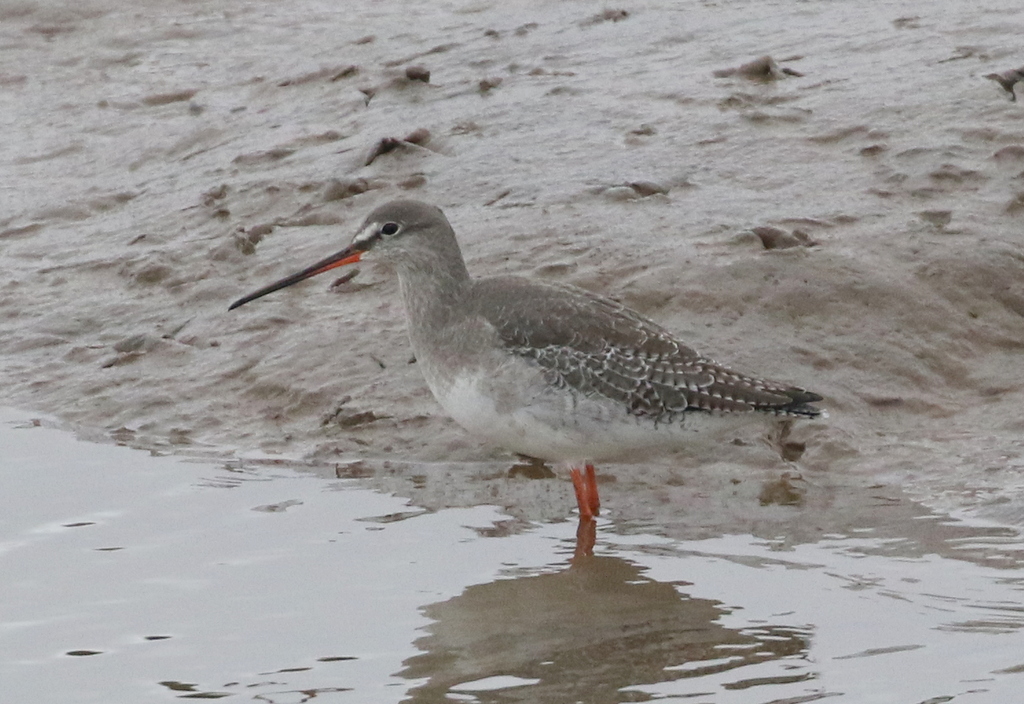
The Spotted Redshank swam across the pool and disappeared behind the old sluice, so we walked round there for a closer look. It was feeding around the edge of the pool, wading up to its belly in the water, sweeping its bill vigorously from side to side. It came out onto the muddy edge and a Common Redshank walked across behind it giving us a good opportunity to compare the two.
A Rock Pipit flew past us calling and dropped down onto the edge of the saltmarsh. It was rather windy this morning and the poor bird was struggling to avoid being blown away out on the mud. Still, we got a great look at it – dark, oily greenish-brown upperparts and dirty underneath with diffuse dark blotches. One to remember for later!
There was no immediate sign of the Twite around the car park, so we were planning to brave the wind and walk up along the seawall. Thankfully, just at that moment the Twite flew in towards us. It looked like they were hoping to go down to drink at the puddles in the car park, but a car was manoeuvring through the middle of them just at that moment, so they circled over but flew off and landed on the roof of the old coal barn. We had a distant look at them through the scope.
We were about to walk over to get a closer view, but with the car having gone, the Twite took off and flew straight towards us. We were right on the edge of the car park but stood very still and they landed straight down on the edge of the puddle just a couple of metres in front of us. We had a front row seat as they drank! We could see their yellow bills and burnt orange breasts. There were 17 of them, winter visitors to the saltmarsh here from the Pennines.
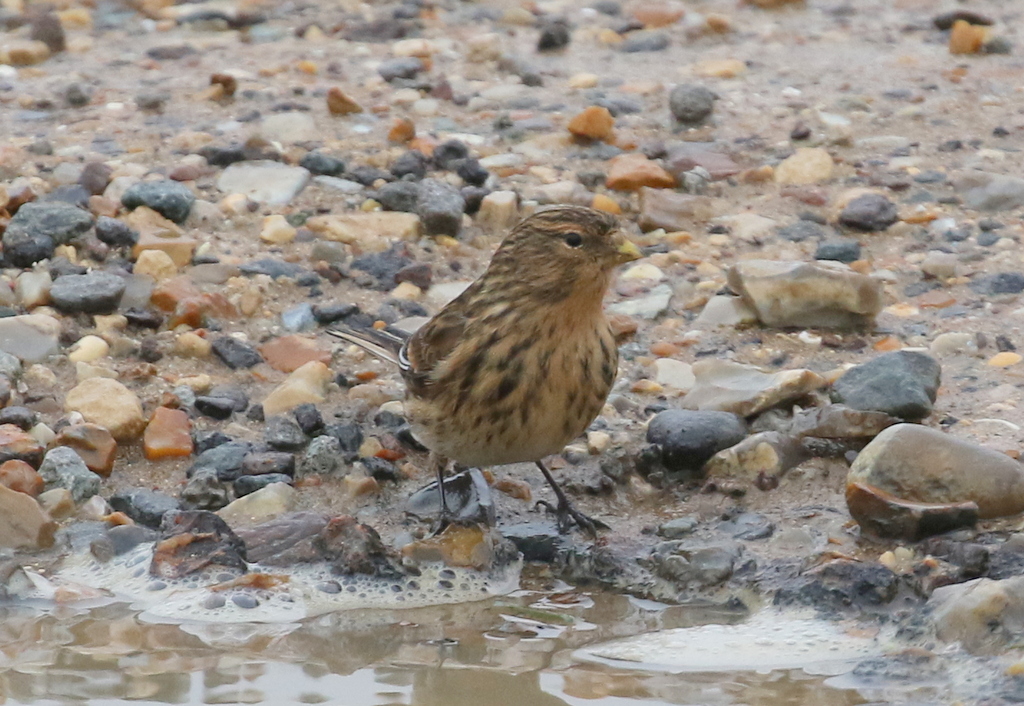
Having seen the Twite so well, we decided against walking out along the seawall, and instead headed off inland to look for some farmland birds. We stopped on the edge of a field, where a cover strip had been sown beside a hedge. We could see lots of birds in the bushes and they were periodically flying in and out of the cover strip to feed. They were mostly Reed Buntings, but in with them we managed to find a couple of Tree Sparrows and one or two Yellowhammers too.
A little further on, we stopped again at another weedy field. At first, all seemed rather quiet, but then several Skylarks flushed from out in the grass and fluttered up singing. Then we noticed several Yellowhammers in the hedge further along, and we walked down for a closer look. We got a smart male in the scope and admired its bright yellow head and chestnut rump.

The Yellowhammers dropped back out into the middle of the field but after a couple of minutes a much bigger flock of buntings came up out of the vegetation. We hoped they might land in the hedge again, but unfortunately disappeared off over the road the other side.
We carried on along the road and hadn’t gone far before we started to flush dozens of finches from the hedges either side, just ahead of us. Most of them landed again a little further along, so we coasted slowly up to them. They were mostly Chaffinches and Goldfinches, but in with them were quite a few Bramblings too. We could make them out from their brighter orange breasts and whiter bellies as they tried to hide in the hedge as we passed.
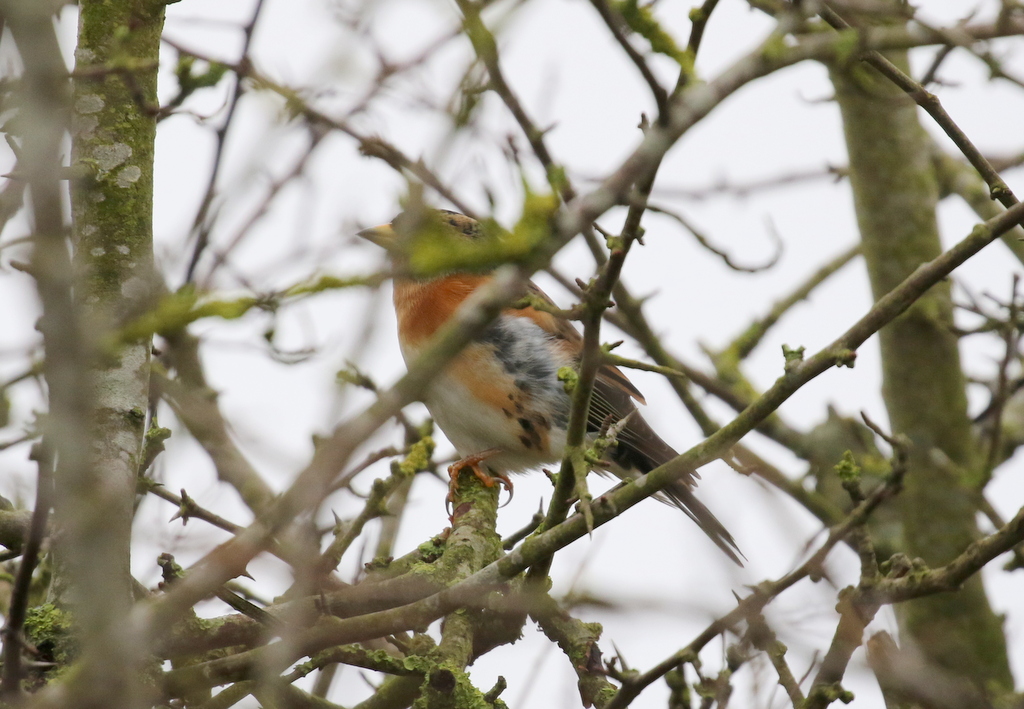
It was great to see so many finches here. They are feeding in a large weedy field which has been sown with seed mix – a fine testament as to what can happen when food is made available for birds. We pulled up in a gateway to watch a Marsh Harrier work its way low along the edge of the field, it too looking to take advantage of the availability of food.
Our destination for the rest of the morning was Titchwell. A Coal Tit was singing from the trees as we got out of the car and a little flock of Long-tailed Tits was feeding in the sallows by the path to the visitor centre. A pair of Kestrels appeared to be displaying to each other around the trees, the male calling and fluttering around below the female. The feeders were rather quiet this morning, so we headed out onto the reserve.
We stopped by the old pool out on Thornham grazing marsh. It looked rather bleak at first, but scanning carefully, we found first a Pied Wagtail and then a Rock Pipit out in the middle. Neither was what we were really hoping for here, but then we noticed a paler bird just in front of them, a Water Pipit. It was very well camouflaged against the mud and hard to see unless it moved, but we all had a good look at it. Rather similar to the Rock Pipit we had seen so well earlier, but noticeably paler off white below, with finer blackish streaks, plus a more prominent pale supercilium and paler wing bars.
A single Marsh Harrier circled over the reeds at the back, and another couple were interacting at the back of the reedbed, the other side. There were a few ducks out on the saltmarsh – a nice little group of Wigeon, plus a pair of Shoveler and a couple of Teal. When they flushed and flew across to the freshmarsh, a couple of Common Snipe appeared up out of the vegetation too. A single Grey Plover was feeding on the edge of the Lavendar Marsh pool.
The water level on the freshmarsh is kept very high through the winter. This is good for diving ducks at the moment, with about thirty Common Pochard and a smaller number of Tufted Ducks in a raft over by the edge of the reeds. Unfortunately, it means there is not much else on here at the moment, apart from a few Teal and Shelduck and a couple of Gadwall.
Avocet numbers are slowly starting to creep up again, after their midwinter low, with twelve today sleeping on the small island which just pokes out above the water by the path to Parrinder Hide.

There were a few more waders on the Volunteer Marsh. Several Common Redshanks were feeding down at the front, with a couple of Ringed Plover and Dunlin around the edge of the muddy channels just behind. Two Black-tailed Godwits were hiding here too, along with singles of Curlew and Grey Plover further back. A small flock of Knot were feeding in the edge of one of the islands of vegetation out in the middle of the mud.
As we walked over the bank towards the Tidal Pools, a small party of Brent Geese took off from the saltmarsh and flew straight over our heads. They disappeared off towards the freshmarsh, presumably to drink and bathe.
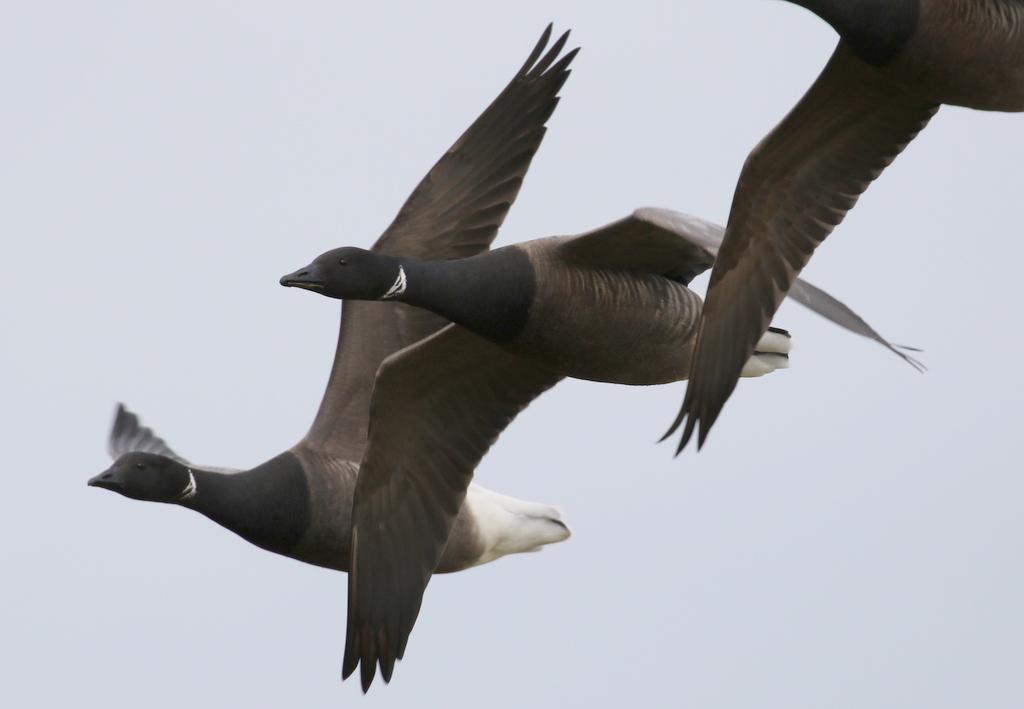
The first thing we noticed on the Tidal Pools were the Little Grebes, three of them which were diving out on the water just beyond the bank. There were a few more duck on here too, and in particularly a little party of Pintail over towards the back corner, busy upending. We got them in the scope and had a look at them – smart ducks!
There were a few more waders on here too – some nice close godwits, both Black-tailed Godwits and Bar-tailed Godwits, which gave us another opportunity to look at the differences between the two species. The Bar-tailed Godwits are slightly smaller, shorter legged, with a bill which turns up slightly, and noticeably paler with streaks on their upperparts.
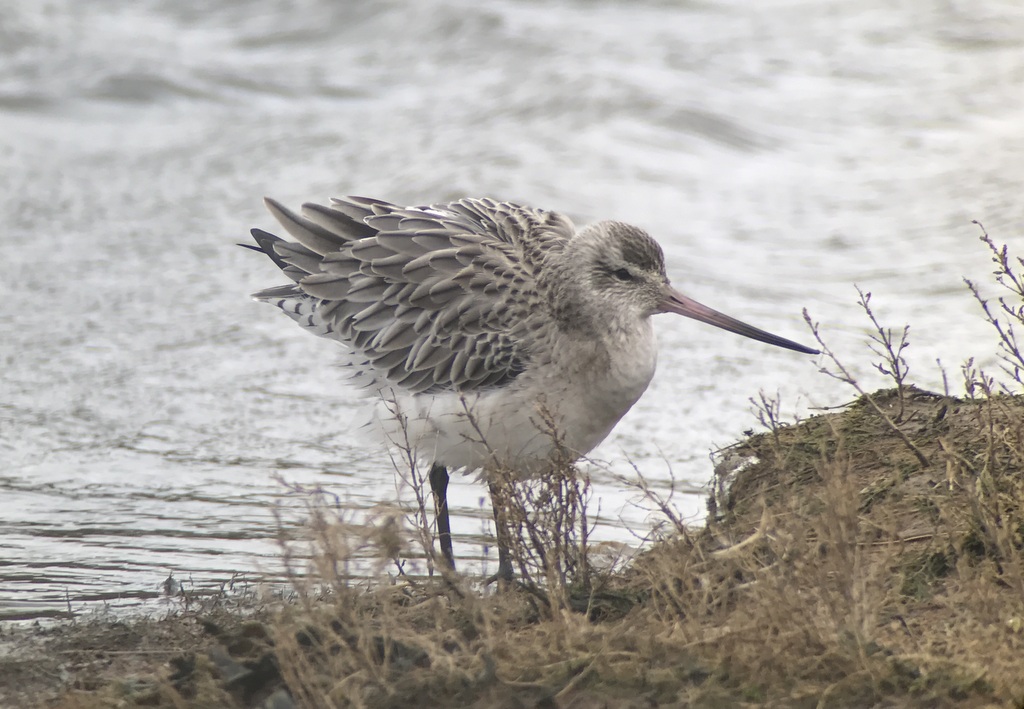
Several Oystercatchers were roosting on the spit at the back of the Tidal Pools, but most of the waders were out on the beach today, although they were flushed as we arrived by a Common Buzzard circling out over the dunes.
The real draw out here at the moment is the seaduck, and we found ourselves a sheltered spot in the lee of the dunes to see what we could see. A quick scan of the sea and we found several Long-tailed Ducks diving just offshore, including a number of smart drakes. They were sporting even longer tails than the drake Pintail we had just been looking at!
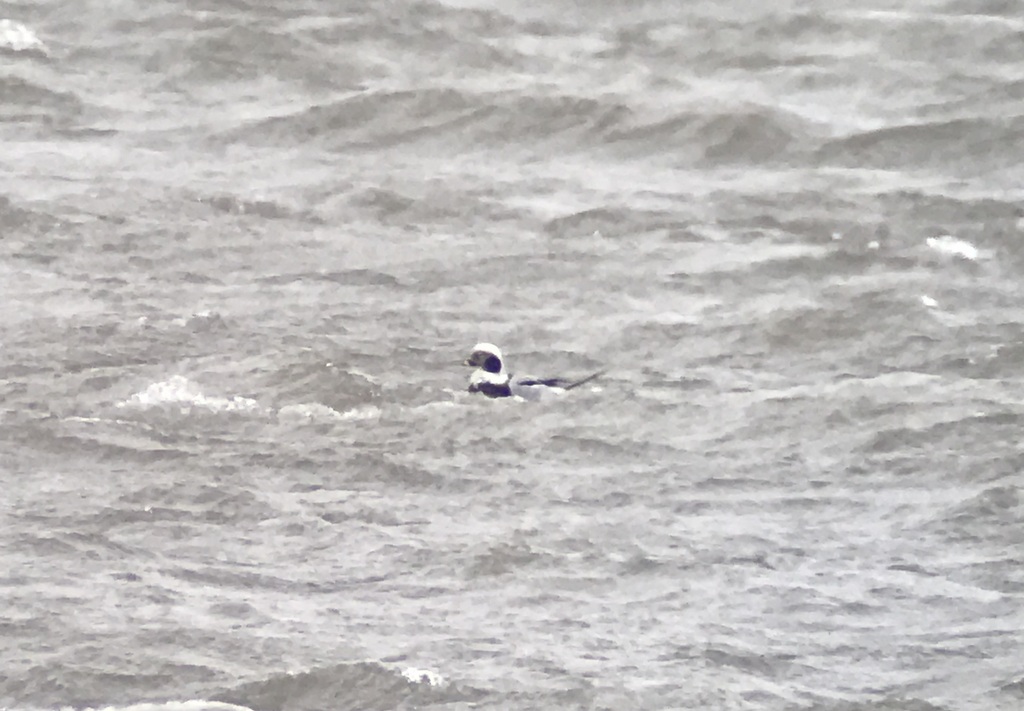
There were several Common Scoter and a good number of Goldeneye on the sea too, which were relatively easy to see, despite all the ducks disappearing in the steady swell. The pair of Red-breasted Mergansers were harder for everyone to get onto, as they were diving constantly, as was the Red-throated Diver. The Guillemots were very hard to see on the water too, but several flew past including one right along the tide line, which was much easier to get onto.
After a productive session out at the beach, we beat a hasty retreat to the Visitor Centre for lunch. Afterwards, we made our way back to the car, with a Treecreeper in the sallows by the path a welcome bonus. Then we made our way back east along the coast to Holkham for the afternoon.
As we drove up Lady Anne’s Drive towards the pines, a Stonechat posed nicely on the fence beside the car. There were lots of Common Redshanks feeding around the pools in the grass, formed by the recent rain. On the other side, a big flock of Wigeon grazing by the fence were spooked by a passing Curlew and flew up whistling noisily.

Out first target here was the flock of Shorelarks which often feed out on the saltmarsh, so we headed straight out through the pines towards the beach. A flock of Linnets was flushed by a dog running around in the middle of the saltmarsh, and whirled round in a tight flock. We turned east and walked along the path below the dunes. We hadn’t gone far when we noticed a large group standing out on the edge of the saltmarsh and saw a flock of nine pale birds whirl round and land down again in front of them – the Shorelarks.
We joined the small crowd and set to admiring the Shorelarks as they scampered around on the saltmarsh just in front of us. The clouds cleared just at that moment and the sun appeared. Perfect timing, as the canary yellow faces of the Shorelarks shone in the low afternoon light. Great birds!
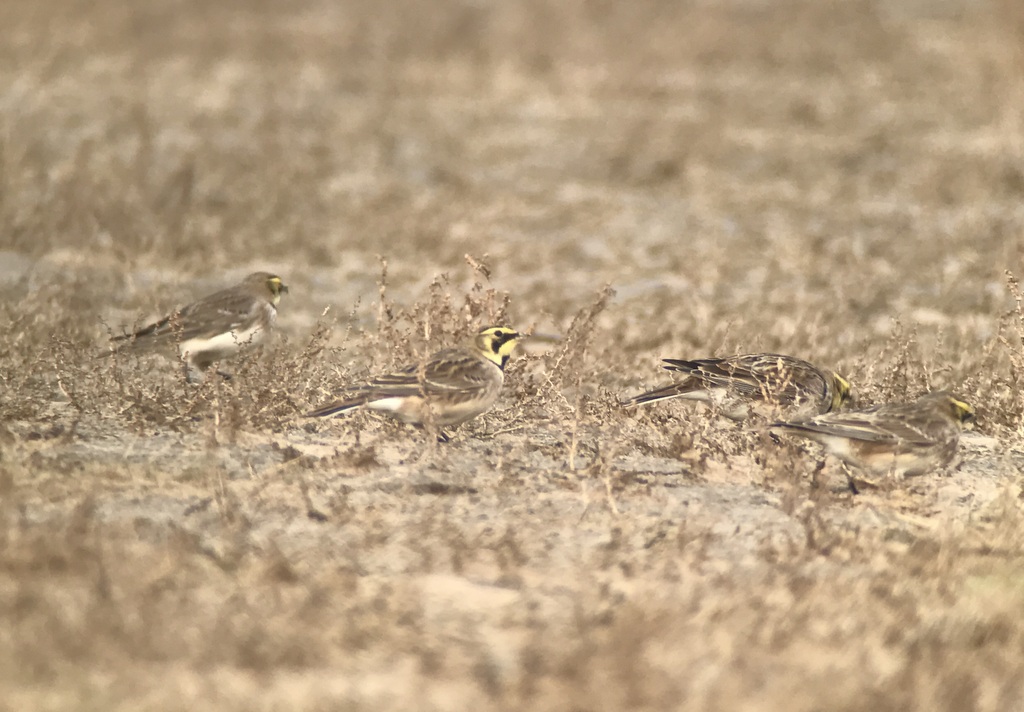
Shorelarks are winter visitors in very small and variable numbers to the UK from Scandinavia. They have declined in recent years, and North Norfolk is now one of the only (fairly) reliable places to see them, so it is always a delight to spend some time watching a flock of Shorelarks here on the coast. They are always better to see in action, so the short video below gives a better sense of how lovely they are to watch!
As we made our way back through the trees, we heard a Goldcrest calling in the holm oaks and watched it flitting around in the dark leaves. A flock of Pink-footed Geese flew in calling and landed out on the grass to the west of Lady Anne’s Drive, so we stopped to have a look at them in the scope.
We had been intending to walk west to the hides this afternoon, but we received a tip that the White-fronted Geese were over the other side of the grazing marsh today, so we drove round there instead. We were soon watching a flock of at least 75 – they were hard to count as they were tucked down behind the trees, but this is the most we have seen here this year. Numbers have been lower than normal this winter, due to mild weather on the continent which means that many of the geese have stayed there.
Through the scope we could see the distinctive white surround to the base of the bill on the adult White-fronted Geese, from which they get their name, and their black belly bars.
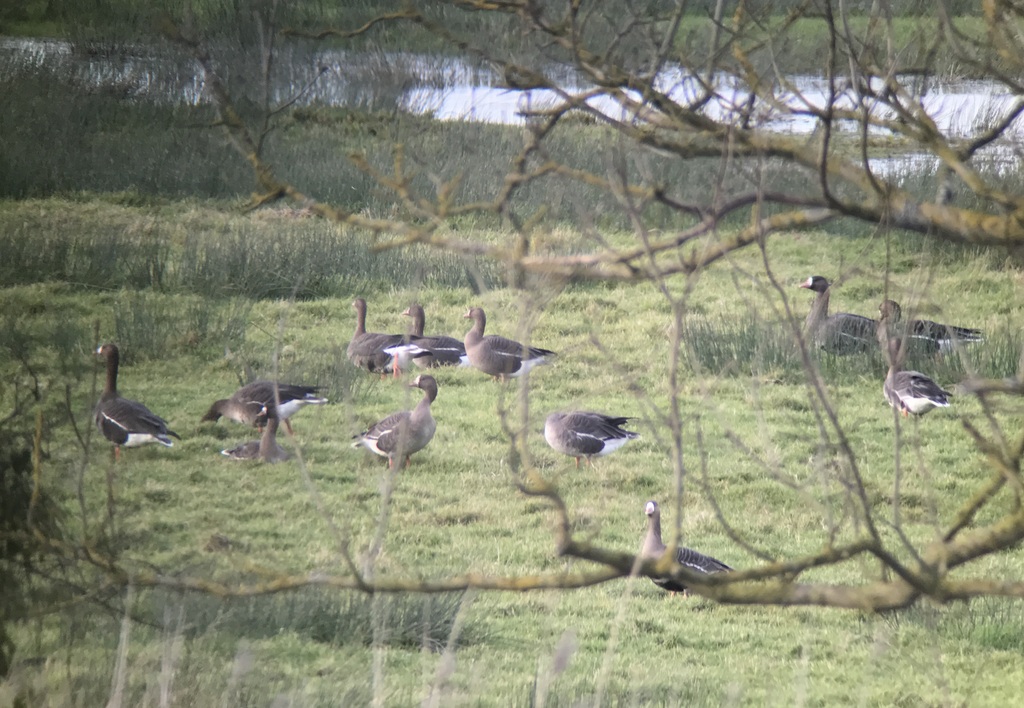
Great White Egrets are now a regular sight at Holkham and a pair bred here for the first time in 2017. They like to feed in the pools and ditches out on the grazing marshes. One was hiding round behind the trees when we arrived, but thankfully flew out and landed in the middle of the marshes where we could get a good look at it.

A Grey Heron flew across in front of us while we were scanning the marshes and a Marsh Harrier was quartering the grazing marshes over towards Meals House, flushing all the Wigeon and Lapwings. A striking pale Common Buzzard was perched in the top of one of the hawthorn bushes.
Having not had to walk out to the hides at Holkham this afternoon, we had an hour to spare now. We decided to drive back along the coast to try to catch up with a few raptors coming in to roost. When we arrived at the car park, we were told we had just missed a male Hen Harrier, but thankfully we were soon watching another, a ringtail, as it made its way slowly past long the back edge of the saltmarsh. Through the scope we could see the distinctive white patch at the base of its tail.
The Hen Harrier dropped down onto the saltmarsh, but when we next saw it a second ringtail was with it. We watched as the two of them tussled with each other, before dropping back down into the vegetation.
Then a Barn Owl appeared. It was distant at first, perched on a signpost along the edge of the saltmarsh from where we were standing. It started to make its way towards us, hunting the grassy bank below the trees, but then three boys appeared between us and the Barn Owl, playing noisily on the edge of the wood, and the owl turned back the other way. The boy’s mother called them in for tea, but it was just to late for us! A little group of Fieldfares flew over the trees tchacking loudly.
Finally, the male Hen Harrier reappeared. We watched as it made its way in from the east, high over the saltmarsh. It dropped down along the northern edge as it passed by in front of us, flushing a Merlin from the bushes below it. The Merlin flew off fast ahead of it, hugging the vegetation. As the male Hen Harrier headed in towards the roost, with the light fading, we decided to call it a day and head for home too.
















